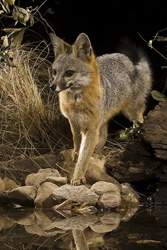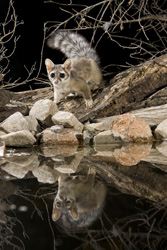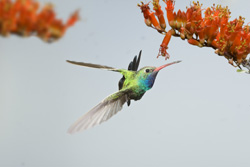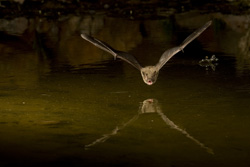

Although opinions on this answer may differ, there is one
tool that some photographers use, that others are completely unfamiliar
with, or are unaware that the tool even exists, or who do not
know how to use this tool. And what is this tool? It is the PhotoTrap,
a unmanned, remote camera or flash trigger that takes photos,
or fires a flash, even when you're not there! With it, one can
set up at a waterhole or a nest box or a den site or a game trail
or feeding station and go to dinner, go to sleep, or go somewhere
else to take photographs while the PhotoTrap fires your camera
and takes images that are often impossible to make any other way.
I bet, in writing this, I've just made some very successful winners
of these contests very unhappy, but this is a secret that should
be shared!
The inventor of the PhotoTrap, Bill Forbes, is a genius when it comes to these devices. I have three different models - two earlier versions that are no longer produced and his latest model, about a third of the size of the original. This version is called the Pro Remote Beam Controller, and operates off a heavy-duty, but small, 12 volt battery that is enclosed within the system. Bill can make a variety of different types of sensors, or tripping devices, but the one I'm using on the latest model is a simple, incredibly ingenious infrared sensor system that can fire three different ways.
The PhotoTrap will fire when the sensor system is separated, where one sensor serves as the transmitter and the other sensor serves as the receiver. In a straight line system (the way any remote camera firing device using sensors usually operates), when something passes through the beam - breaking the beam - the camera or flash fires.
The PhotoTrap also fires when the two sensors are places next to each other, so that the transmitter and the receiver are adjacent. In this mode, when something passes within reflective range of the transmitted beam, the infrared light is reflected back to the receiver, and when this happens, the camera fires. This is one of the most exciting features of the PhotoTrap because this allows you to place the sensors together, in just one location, and by doing so you won't be obstructing the potential path of your subject. Years ago, I used the now discontinued Dalebeam, and then the Shutterbeam (a great refinement on the Dalebeam) to photograph bluebirds, tree swallows, and wrens in my yard, but I had to place the 'Beam on one side and a reflector opposite, so that a passing bird broke the beam and fired my camera. For this to work, I had to have a beam and reflector flanking the flight path, and more often than not the bird would fly around, and sometimes perch on top of, either the 'Beam or the reflector. No matter how I worked it, I still had to work with a reflector and receiver at opposite ends of one another, and this compromised things immensely.
This won't happen with the PhotoTrap set in the above described position, with the transmitter and receiver adjacent one another ( a velcro strip attaches the two firmly together). In this fashion, the sensors can be placed BELOW a nest hole or nesting box, aimed skyward without anything above to impede the movement of the bird. When the bird flies in, its body reflects the infrared light transmitted from the transmitter, back to the receiver, and the camera fires. It's almost foolproof in this fashion!
 Recently,
on our Arizona
High Speed Flash Photography Shoot, I used this mode to capture
opossums, ringtails, and gray fox coming to my man-made waterhole
while I slept! I had the transmitter/reciever positioned so that
a mammal coming in to water reflected the beam and the camera
fired. The trick to this is that the beam travels about 3 to 5
feet, depending upon lighting conditions, so if a background is
within that range the beam might fire a camera prematurely. Likewise,
if the subject is beyond this 3 to 5 foot distance, the beam may
not reflect and the camera won't fire. The trick, then, is to
move the transmitter/receiver in and out until you get just the
right distance. A lot of work ... maybe five minutes or so, and
less if the light is low at dusk. I'm kidding about the work ---
that's pretty darned fast!
Recently,
on our Arizona
High Speed Flash Photography Shoot, I used this mode to capture
opossums, ringtails, and gray fox coming to my man-made waterhole
while I slept! I had the transmitter/reciever positioned so that
a mammal coming in to water reflected the beam and the camera
fired. The trick to this is that the beam travels about 3 to 5
feet, depending upon lighting conditions, so if a background is
within that range the beam might fire a camera prematurely. Likewise,
if the subject is beyond this 3 to 5 foot distance, the beam may
not reflect and the camera won't fire. The trick, then, is to
move the transmitter/receiver in and out until you get just the
right distance. A lot of work ... maybe five minutes or so, and
less if the light is low at dusk. I'm kidding about the work ---
that's pretty darned fast!
The third way the two sensors work are, to me, the most incredible. You can set the two sensors to be at right angles to one another, or virtually any other angle for that matter, so that the subject has to pass through a specific point in space to trigger the system. I used this for my 'fun' hummingbird shooting outside our room at the lodge where we were staying. One beam was placed horizontally, aimed a little bit behind the feeding tube where the hummingbirds visited. The other beam was placed below the feeder and aimed skyward, again a bit behind the feeding tube. When a hummer flew in, it broke the beam before it reached the feeding tube and my camera fired.
 On
my last full day in Arizona, as I packed up 50-some flashes, dozens
of Bogen Magic Arms and Articulating Arms, light stands, and wooden
sets, I kept one feeder open, rigged with the PhotoTrap. On that
day I shot almost 20 gigabytes of images in one day! All I had
to do was arrange my flashes and set the light I wanted, focus
my camera, and turn everything on. I broke down my sets, packed
my truck to the gills with gear, and while I did this, I shot
wonderful images of hummingbirds in flight!
On
my last full day in Arizona, as I packed up 50-some flashes, dozens
of Bogen Magic Arms and Articulating Arms, light stands, and wooden
sets, I kept one feeder open, rigged with the PhotoTrap. On that
day I shot almost 20 gigabytes of images in one day! All I had
to do was arrange my flashes and set the light I wanted, focus
my camera, and turn everything on. I broke down my sets, packed
my truck to the gills with gear, and while I did this, I shot
wonderful images of hummingbirds in flight!
Bill, the inventor, is a wizard, and he can work with you to meet your particular shooting needs. For example, several years ago I wanted to photograph mud dauber wasps flying in to their nest (a vertical mud tunnel attached to a wall next to a light fixture at our studio), hoping that I'd catch the wasp carrying in a spider. Mud daubers catch and paralyze spiders, which they pack into the tunnel before laying an egg upon the living, but immobile, spider. I needed a reciver that was tiny and would lie flat against the wall, since the space involved was really very tight. I called Bill, explained the problem, and soon after he sent me a receiver that was tiny and flat and fit into the space I had, and I got my shots. I didn't catch the wasp with a spider, but that was just bad luck -- the PhotoTrap did its job, the wasp didn't.
 I've
shot with Bill as we've photographed bats, including just recently
at his shooting locale in southern Arizona, The Pond, where we
worked one evening on bats skimming the pond for a drink. Bill
made a specific array of sensors for this -- again, a product
that will be available for sale -- and I got several shots of
the beautiful and impressive Pallid Bat and some smaller brown
bats as they skimmed the water. That was so much fun we're going
to incorporate that as an optional shoot on our Arizona High Speed
Flash Hummingbird Shoot for 2009!
I've
shot with Bill as we've photographed bats, including just recently
at his shooting locale in southern Arizona, The Pond, where we
worked one evening on bats skimming the pond for a drink. Bill
made a specific array of sensors for this -- again, a product
that will be available for sale -- and I got several shots of
the beautiful and impressive Pallid Bat and some smaller brown
bats as they skimmed the water. That was so much fun we're going
to incorporate that as an optional shoot on our Arizona High Speed
Flash Hummingbird Shoot for 2009!
My very good friend, Dave Northcott, uses the PhotoTrap for his incredible shots of jumping geckos, lizards, treefrogs, and other herptiles. I've used it in a similar fashion, as well as for Southern flying squirrels here at Hoot Hollow, Australian sugar gliders, striking diamondback rattlesnakes, flying owls, and more.
OK, there is one disadvantage to using the PhotoTrap and that
is you might be accused that you're not taking great images, the
camera is! Believe it or not, I've actually heard that criticism
as the critic felt that one needed to be behind the camera, and
pressing the shutter, for it to be 'your' image. I believe that
is an absurd conception, since one must prefocus, precompose,
PREVISUALIZE, and then effectively light the scene, if using flash,
in order for you to make a great image. To me, that is a heck
of a lot harder than being behind the camera and pointing and
shooting, and although it is harder, it is also infinitely more
rewarding and exciting. Although National Geographic probably
has their own custom-made tools to do a similar job, the June
2008 issue of that magazine shows the rarely photographed snow
leopard filmed via camera traps. Most of the images are very well
lit, via flash, illustrating my point that the photographer had
to employ a great deal of field craft and natural history to get
the camera trap in the right place, then he had to employ very
impressive photographic skills as he set up his composition and
arranged his lights to make these incredible images. While you
or I may never have a chance to film snow leopards in the wild,
we can do other animals. In the US I've photographed bobcats,
ringtails, raccoons, skunks, bats, kangaroo rats, deer, armadillos,
deer mice, flying squirrels, and numerous species of birds, insects,
and herptiles in this way, making images otherwise rather difficult
or impossible to make. You can, too, like the pros winning these
contests often do!
Does the automatic sensor cleaning feature of the Mark
III really work?
What is our initial Digital Workflow?
What is our Digital Workflow
in the Lab?
How
do I keep track of Digital Files?
Is Shooting in the RAW
format worthwhile?
What
is the Difference?
How can you capture
a sharp image and angel hair on a windy day?
Can you match
the Histograms?
How
do we meter White?
Is the Mark
II the ultimate wildlife digital camera?
What
is DEC?
Wildlife
Models - Is there anything new to shoot?
Do
You Need a Big Printer?
Can
a Wimberley Head be used with small lenses?
What
is Reality? Adobe's powerful LIGHTROOM Program
Why
must you have at least 2 digital backups?
Is Digital Manipulation
- a benign alternative to interacting in the natural world?
Film
or Digital? - Why
you should shoot film!
Does the Visibledust
cleaning system really work?
LensCoat
camera, lens, and tripod covers
What Equipment
do we usually take afield?
Does
the AutoFocus on the EOS 1D Mark III work?
Which Macro Lens is for You?
What is the Most Important thing you can do before a Workshop?
How
many Flashes do you need to effectively illuminate hummingbirds?
What
is the best shutter speed for panning running mammals?
Is
there an easy way to level a camera for panorama shots?
Is
the New Wimberley head worth having?
Is an L-Shaped Camera
Bracket worth the Money? You bet it is!
Using Zoom
lenses with tele-converters and extension tubes -- can you use
both together?
Are Image Stabilization
Lenses Worth the Money?
What
the heck is the Scheimpflug Law?
What
is the Best Composition?
Should
you have a depth of field Preview button on your camera?
How
do you determine distances?
Hyperfocal Distance
Apertures
for Macro
Flash and
Tele-flash Techniques
What
is the best flash for closeup and macro photography?
What is the
most versatile remote release camera firing system?
How
do you shoot high-speed action images?
How
did I shoot the gliding Sugar Glider?
How did I
photograph that flying wasp?
What the
heck is a Plamp?
Can
Photographing Wildlife Models make Conservation Sense?
Is Kenya safe to visit in 2008?
What I did on my summer 'vacation.'
Why is Yellowstone the best for wildlife photography in the US?
Is
a Trip to Antarctica Worth it?
What is the best season
to do a photo safari in East Africa?
What is the Big Lie?
The truth about Kenya's Tourism--it is SAFE!
Which Mountain
Park is better for wildlife - Denali or Torres del Paine?
What
are our Five Favorite Shooting Locales?
How can you
attract insectivorous birds to your feeding stations and bait
sites?
How do you
make things happen in wildlife photography?
What is the
best Car Window Mount?
How
can you save your shoulders?
How can you reduce
contrast and the effect of wind for flower and macro photography?
What
is the best Game Caller?
How Easy
is Whale Photography?
Why
Can't You Feed A Bear?
What is our
Favorite bird-shooting location?
Contact us by e-mail: info@hoothollow.com